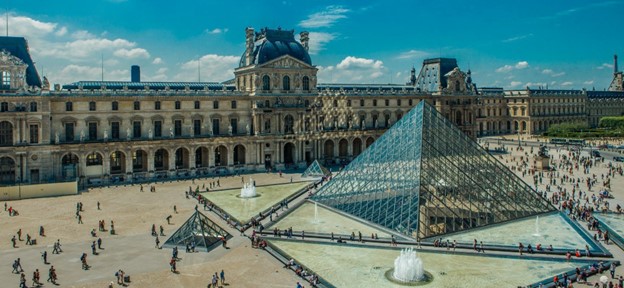The Louvre, standing proudly on the banks of the Seine in Paris, is not just a museum; it’s a cultural behemoth, a treasure trove housing some of the world’s most iconic artworks. Navigating the Louvre is a journey through history, art, and architectural brilliance, making it a must-visit destination for art enthusiasts and curious minds alike.
Introduction
As the world’s largest art museum, the Louvre holds a special place in the hearts of art lovers and historians. Home to thousands of years of human creativity, this iconic institution stands as a testament to the enduring power of art in shaping our understanding of the world…
History and Architecture of the Louvre
The Louvre’s story is as rich as the art it houses. From a medieval fortress to a royal palace and finally a public museum, its history reflects the evolution of art and culture. The museum’s architecture, a blend of historic structures and modern additions, culminates in the iconic glass pyramid that graces its entrance.
The Vast Art Collection
The Louvre’s art collection is vast and diverse, spanning different cultures, time periods, and artistic movements. From ancient Egyptian artifacts to Renaissance masterpieces, the museum’s galleries offer a comprehensive exploration of human creativity.
Must-See Masterpieces
While every inch of the Louvre is a treasure trove, certain masterpieces stand out. The enigmatic smile of the Mona Lisa, the graceful form of the Venus de Milo, and the grandeur of Liberty Leading the People are just a few of the iconic works that captivate visitors from around the world.
Navigating the Louvre: Tips and Tricks
Navigating the Louvre’s expansive halls can be overwhelming, but with a few tips, visitors can make the most of their experience. Skip-the-line options, guided tours, and strategic routes can help maximize time and ensure a more enjoyable visit.
Louvre for Art Enthusiasts
For those with a deeper passion for art, the Louvre offers specialized tours and programs. From thematic explorations of specific periods to in-depth discussions led by experts, these opportunities provide a more profound understanding of the artworks.
Family-Friendly Louvre
Families are welcomed at the Louvre, with amenities and activities tailored for children. Educational programs, interactive exhibits, and family-friendly guides make the museum an enriching experience for visitors of all ages.
Temporary Exhibitions and Events
The Louvre continually refreshes its offerings with temporary exhibitions, showcasing diverse artists and themes. Visitors are encouraged to check for these special displays, adding a dynamic element to each visit. Additionally, the museum hosts cultural events and programs throughout the year.
Louvre’s Gardens and Outdoor Spaces
Beyond its walls, the Louvre extends into the picturesque Tuileries Garden. Visitors can take a leisurely stroll through these outdoor spaces, providing a refreshing contrast to the intensity of the artworks inside.
Dining and Shopping at the Louvre
Taking a break within the Louvre is a delightful experience, with various dining options offering a culinary journey. The museum’s shops provide an array of art-inspired souvenirs, allowing visitors to take a piece of the Louvre home.
Technology and the Louvre
In the digital age, the Louvre embraces technology to enhance the visitor experience. Interactive apps, virtual tours, and digital resources contribute to a more immersive exploration of the artworks. Additionally, technology plays a crucial role in the preservation and presentation of the museum’s vast collection.
Accessibility and Inclusivity
The Louvre is committed to making art accessible to all. Efforts are in place to accommodate diverse needs, including wheelchair accessibility, sensory-friendly programs, and inclusive initiatives that promote a welcoming environment for every visitor.
Preservation and Conservation Efforts
Preserving and conserving artworks is a paramount concern for the Louvre. Ongoing initiatives ensure the longevity of the collection, with dedicated efforts to maintain the integrity of each piece.
Visitor Etiquette and Cultural Considerations
Respecting the Louvre’s treasures and fellow visitors is key to a positive experience. From appropriate behavior in galleries to cultural considerations when encountering diverse artworks, understanding visitor etiquette adds to the enjoyment of the museum.
Conclusion
In conclusion, stepping inside the Louvre is not just a visit to a museum; it’s a journey through time, culture, and human creativity. From the grandeur of its architecture to the exquisite artworks within, the Louvre offers an unparalleled experience. As you plan your visit, prepare to be enchanted by the world’s largest art museum, where every step is a brushstroke in the masterpiece of art history.
FAQs
Q: How much time should I allocate for a visit to the Louvre?
- A: While it depends on individual preferences, a recommended time is at least half a day to a full day to explore the Louvre thoroughly.
Q: Are there audio guides available for visitors?
- A: Yes, the Louvre provides audio guides in multiple languages, offering detailed information about key artworks and exhibits.
Q: Can I purchase tickets online, and is there a benefit to doing so?
- A: Yes, purchasing tickets online allows for skip-the-line access, saving time and ensuring a smoother entry into the museum.
Q: Are there any restrictions on photography within the Louvre?
- A: While photography is generally allowed, some exhibits may have restrictions. It’s advisable to check signs and guidelines within specific galleries.
Q: What is the best time to visit the Louvre to avoid crowds?
- A: To minimize crowds, consider visiting during weekdays, especially in the morning or later in the afternoon. The Louvre is typically busiest on weekends and holidays.

